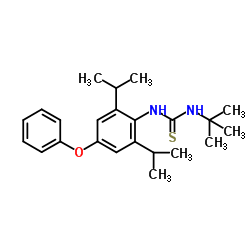Toxicity of diafenthiuron to honey bees in laboratory, semi-field and field conditions.
Johnson Stanley, Subramanian Chandrasekaran, Gnanadhas Preetha, Sasthakutty Kuttalam
Index: Pest Manag. Sci. 66(5) , 505-10, (2010)
Full Text: HTML
Abstract
Cardamom, an important spice crop often attacked by many insect pests, is controlled mainly using synthetic insecticides. As honey bees play a vital role in pollination in cardamom, the impact of insecticides on honey bees needs to be explored to assess its safety.Risk assessment based on contact toxicity revealed diafenthiuron to be a non-selective insecticide to bees with a low selectivity ratio (the ratio between the LD(50) for beneficial and pest species). A dose of diafenthiuron that killed 90% of cardamom borer, Conogethes punctiferalis Guenee, was found to kill 100% of Indian bees. Based on the hazard ratio (the ratio between the field-recommended dose and the LD(50) for the beneficial), diafenthiuron was found to be slightly to moderately toxic to bees. Diafenthiuron, even at low concentrations of LC(1) (the concentration that killed 1% of bees), was found to affect the foraging and homing behaviour of Indian bees. Of bees fed with 30 microg mL(-1) of diafenthiuron, 40% were found missing on the third day after exposure. However, diafenthiuron did not affect bee visits to the cardamom fields.Diafenthiuron is more highly toxic to Apis cerana indica F. than to C. punctiferalis by contact, using selectivity ratio and probit substitution methods of risk assessment, but the hazard ratio revealed diafenthiuron to be a slightly to moderately toxic chemical. Diafenthiuron was found to affect the foraging and homing behaviour of bees at sublethal concentrations. Thus, sublethal effects are more relevant in risk assessment than lethal and acute effects.
Related Compounds
| Structure | Name/CAS No. | Molecular Formula | Articles |
|---|---|---|---|
 |
Diafenthiuron
CAS:80060-09-9 |
C23H32N2OS |
|
Multi-residue method for determination of 238 pesticides in ...
2014-11-26 [J. Agric. Food Chem. 62(47) , 11449-56, (2014)] |
|
Diafenthiuron residue and decline in pakchoi and soil under ...
2012-05-01 [Ecotoxicol. Environ. Saf. 79 , 75-9, (2012)] |
|
Field efficacy and baseline toxicities of pyriproxifen, acet...
2003-11-01 [J. Environ. Sci. Health B 38(6) , 757-69, (2003)] |
|
Photodegradation of diafenthiuron in water.
2002-05-01 [Pest Manag. Sci. 58(5) , 496-502, (2002)] |
|
Metabolism of diafenthiuron by microsomal oxidation: procide...
2001-10-01 [Pest Manag. Sci. 57(10) , 975-80, (2001)] |